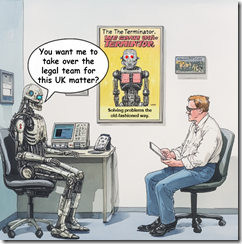Google: Making a Buck Is the Name of the Game
December 30, 2024
 This blog post was crafted by a still-living dinobaby.
This blog post was crafted by a still-living dinobaby.
This is a screenshot of YouTube with an interesting advertisement. Take a look:
Here’s a larger version of the ad:
Now here’s the landing page for the teaser which looks like a link to a video:
The site advertising on YouTube.com is Badgeandwallet.com. The company offers a number of law enforcement related products. Here’s a sample of the badges available to a person exploring the site:
How many law enforcement officers are purchasing badges from an ad on YouTube? At some US government facilities, shops will provide hats and jackets with agency identification on them. However, to make a purchase, a visitor to the store must present current credentials.
YouTube.com and its parent are under scrutiny for a number of the firm’s business tactics. I reacted negatively to the inclusion of this advertisement in search results related to real estate in Beverly Hills, California.
Is Google the brilliant smart software company it says it is, or is the company just looking to make a buck with ads likely to be viewed by individuals who have little or nothing to do with law enforcement or government agencies?
I hope that 2025 will allow Google to demonstrate that it wants to be viewed as a company operating with a functioning moral compass. My hunch is that I will be disappointed as I have been with quantum supremacy and Googley AI.
Stephen E Arnold, December 30, 2025
Modern Management Revealed and It Is Jaundiced with a Sickly Yellowish Cast
December 26, 2024
 This blog post is the work of an authentic dinobaby. No smart software was used.
This blog post is the work of an authentic dinobaby. No smart software was used.
I was zipping through the YCombinator list of “important” items and spotted this one: “Time for a Code-Yellow?: A Blunt Instrument That Works.” I associated Code Yellow with the Google knee jerk in early 2023 when Microsoft rolled out its smart software deal with OpenAI. Immediately Google was on the backfoot. Word filtered across the blogs and “real” news sources that the world’s biggest online ad outfit and most easily sued company was reeling. The company declared a “Code Yellow,” a “Code Red,” and probably a Code 300 Terahertz to really goose the Googlers.
Grok does a code yellow. Good enough.
I found the reaction, the fumbling, and the management imperative as wonky as McKinsey getting ensnared in its logical opioid consulting work. What will those MBAs come up with next?
The “Time for a Code Yellow” is interesting. Read it. I want to focus on a handful of supplemental observations which appeared in the comments to the citation for the article. These, I believe, make clear the “problem” that is causing many societal problems including the egregious actions of big companies, some government agencies, and those do-good non-governmental organizations.
Here we go and the italics are my observation on the individual insights:
Tubojet1321 says: “If everything is an emergency, nothing is an emergency.” Excellent observation.
nine_zeros says: “Eventually everyone learns inaction.” Yep, meetings are more important than doing.The fix is to have another meeting.
magical hippo says: “My dad used to flippantly say he had three piles of papers on his desk: “urgent”, “very urgent” and “no longer urgent”. The modern organization creates bureaucratic friction at a much faster pace.
x0x0 says: “I’m utter sh*t at management, [I] refuse to prioritize until it’s a company-threatening crisis, and I’m happy to make my team suffer for my incompetence.” Outstanding self critique.
Lammy says: “The etymology is not green/yellow/red. It’s just not-Yellow or yes-Yellow. See Stephen Levy’s In The Plex (2011) pg186: ‘A Code Yellow is named after a tank top of that color owned by engineering director Wayne Rosing. During Code Yellow a leader is given the shirt and can tap anyone at Google and force him or her to drop a current project to help out. Often, the Code Yellow leader escalates the emergency into a war room situation and pulls people out of their offices and into a conference room for a more extended struggle.’ Really? I thought the popularization of “yellow” as a caution or warning became a shared understanding in the US with the advent of trains long before T shirts and Google. Note: Train professionals used a signaling system before Messrs. Brin and Page “discovered” Jon Kleinberg’s CLEVER patent.
lizzas says: “24/7 oncall to … be yanked onto something the boss fancies. No thanks. What about… planning?” Planning. Let’s call a meeting, talk about a plan, then have a meeting to discuss options, and finally have a meeting to do planning. Sounds like a plan.
I have a headache from the flashing yellow lights. Amazing about Google’s originality, isn’t it? Oh, over the holiday downtime, check out Dr. Jon Kleinberg and what he was doing at IBM’s Almaden Research Laboratory in US6112202, filed in 1997. Are those yellow lights still flashing?
Stephen E Arnold, December 26, 2024
Does Apple Thinks Google Is Inept?
December 25, 2024
At a pre-holiday get together, I heard Wilson say, “Don’t ever think you’re completely useless. You can always be used as a bad example.”
I read the trust outfit’s write up “Apple Seeks to Defend Google’s Billion Dollar Payments in Search Case.” I found the story cutting two ways.
Apple, a big outfit, believes that it can explain in a compelling way why Google should be paying Apple to make Google search the default search engine on Apple devices. Do you remember the Walt Disney film The Hunchback of Notre Dame? I love an argument with a twisted back story. Apple seems to be saying to Google: “Stupidity is far more dangerous than evil. Evil takes a break from time to time. Stupidity does not.”
The Thomson Reuters article offers:
Apple has asked to participate in Google’s upcoming U.S. antitrust trial over online search, saying it cannot rely on Google to defend revenue-sharing agreements that send the iPhone maker billions of dollars each year for making Google the default search engine on its Safari browser.
Apple wants that $20 billion a year and certainly seems to be sending a signal that Google will screw up the deal with a Googley argument. At the same holiday party, Wilson’s significant other observed, ““My people skills are just fine. It’s my tolerance to idiots that needs work.” I wonder if that person was talking about Apple?
Apple may be fearful that Google will lurch into Code Yellow, tell the jury that gluing cheese on pizza is logical, and explain that it is not a monopoly. Apple does not want to be in the court cafeteria and hear, “I heard Google ask the waiter, “How do you prepare chicken?” The waiter replied, “Nothing special. The cook just says, “You are going to die.”
The Thomson Reuters’ article offers this:
Apple wants to call witnesses to testify at an April trial. Prosecutors will seek to show Google must take several measures, including selling its Chrome web browser and potentially its Android operating system, to restore competition in online search. “Google can no longer adequately represent Apple’s interests: Google must now defend against a broad effort to break up its business units,” Apple said.
I had a professor from Oklahoma who told our class:
“If Stupidity got us into this mess, then why can’t it get us out?”
Apple and Google arguing in court. Google has a lousy track record in court. Apple is confident it can convince a court that taking Google’s money is okay.
Albert Eistein allegedly observed:
The difference between stupidity and genius is that genius has its limits.
Yep, Apple and Google, quite a pair.
Stephen E Arnold, December 25, 2024
Google AI Videos: Grab Your Popcorn and Kick Back
December 20, 2024
 This blog post is the work of an authentic dinobaby. No smart software was used.
This blog post is the work of an authentic dinobaby. No smart software was used.
Google has an artificial intelligence inferiority complex. In January 2023, it found itself like a frail bathing suit clad 13 year old in the shower room filled with Los Angeles Rams. Yikes. What could the inhibited Google do? The answer has taken about two years to wend its way into Big Time PR. Nothing is an upgrade. Google is interacting with parallel universes. It is redefining quantum supremacy into supremest computer. It is trying hard not to recommend that its “users” use glue to keep cheese on its pizza.
Score one for the Grok. Good enough, but I had to try the free X.com image generator. Do you see a shivering high school student locked out of the gym on a cold and snowy day? Neither do I. Isn’t AI fabulous?
Amidst the PR bombast, Google has gathered 11 videos together under the banner of “Gemini 2.0: Our New AI Model for the Agentic Era. What is an “era”? As I recall, it is a distinct period of history with a particular feature like online advertising charging everyone someway or another. Eras, according to some long-term thinkers, are millions of years long; for example, the Mesozoic Era consists of the Triassic, Jurassic, and Cretaceous periods. Google is definitely thinking in terms of a long, long time.
Here’s the link to the playlist: https://www.youtube.com/playlist?list=PLqYmG7hTraZD8qyQmEfXrJMpGsQKk-LCY. If video is not your bag, you can listen to Google AI podcasts at this link: https://deepmind.google/discover/the-podcast/.
Has Google neutralized the blast and fall out damage from Microsoft’s 2023 OpenAI deal announcement? I think it depends on whom one asks. The feeling of being behind the AI curve must be intense. Google invented the transformer technology. Even Microsoft’s Big Dog said that Google should have been the winner. Watch for more Google PR about Google and parallel universes and numbers too big for non Googlers to comprehend.
Somebody give that kid a towel. He’s shivering.
Stephen E Arnold, December 20, 2024
A Monopolist CEO Loses His Cool: It Is Our AI, Gosh Darn It!
December 17, 2024
 This blog post flowed from the sluggish and infertile mind of a real live dinobaby. If there is art, smart software of some type was probably involved.
This blog post flowed from the sluggish and infertile mind of a real live dinobaby. If there is art, smart software of some type was probably involved.
“With 4 Words, Google’s CEO Just Fired the Company’s Biggest Shot Yet at Microsoft Over AI” suggests that Sundar Pichai is not able to smarm his way out of an AI pickle. In January 2023, Satya Nadella, the boss of Microsoft, announced that Microsoft was going to put AI on, in, and around its products and services. Google immediately floundered with a Sundar & Prabhakar Comedy Show in Paris and then rolled out a Google AI service telling people to glue cheese on pizza.
Magic Studio created a good enough image of an angry executive thinking about how to put one of his principal competitors behind a giant digital eight ball.
Now 2025 is within shouting distance. Google continues to lag in the AI excitement race. The company may have oodles of cash, thousands of technical wizards, and a highly sophisticated approach to marketing, branding, and explaining itself. But is it working.
According to the cited article from Inc. Magazine’s online service:
Microsoft CEO Satya Nadella had said that “Google should have been the default winner in the world of big tech’s AI race.”
I like the “should have been.” I had a high school English teacher try to explain to me as an indifferent 14-year-old that the conditional perfect tense suggests a different choice would have avoided a disaster. Her examples involved a young person who decided to become an advertising executive and not a plumber. I think Ms. Dalton said something along the lines “Tom would have been happier and made more money if he had fixed leaks for a living.” I pegged the grammatical expression as belonging to the “woulda, coulda, shoulda” branch of rationalizing failure.
Inc. Magazine recounts an interview during which the interlocuter set up this exchange with the Big Dog of Google, Sundar Pichai, the chief writer for the Sundar & Prabhakar Comedy Show:
Interviewer: “You guys were the originals when it comes to AI.” Where [do] you think you are in the journey relative to these other players?”
Sundar, the Googler: I would love to see “a side-by-side comparison of Microsoft’s models and our models any day, any time. Microsoft is using someone else’s models.
Yep, Microsoft inked a deal with the really stable, fiscally responsible outfit OpenAI and a number of other companies including one in France. Imagine that. France.
Inc. Magazine states:
Google’s biggest problem isn’t that it can’t build competitive models; it’s that it hasn’t figured out how to build compelling products that won’t destroy its existing search business. Microsoft doesn’t have that problem. Sure, Bing exists, but it’s not a significant enough business to matter, and Microsoft is happy to replace it with whatever its generative experience might look like for search.
My hunch is that Google will not be advertising on Inc.’s site. Inc. might have to do some extra special search engine optimization too. Why? Inc.’s article repeats itself in case Sundar of comedy act fame did not get the message. Inc. states again:
Google hasn’t figured out the product part. It hasn’t figured out how to turn its Gemini AI into a product at the same scale as search without killing its real business. Until it does, it doesn’t matter whether the competition uses someone else’s models.
With the EU competition boss thinking about chopping up the Google, Inc. Magazine and Mr. Nadella may struggle to get Sundar’s attention. It is tough to do comedy when tragedy is a snappy quip away.
Stephen E Arnold, December 17, 2024
Google: More Quantum Claims; Some Are Incomprehensible Like Multiple Universes
December 16, 2024
 This blog post is the work of an authentic dinobaby. No smart software was used.
This blog post is the work of an authentic dinobaby. No smart software was used.
Beleaguered Google is going all out to win a PR war against the outfits using its Transformer technology. Google should have been the de facto winner of the smart software wars. I think the president of Microsoft articulated a similar sentiment. That hurts, particularly when it comes from a person familiar with the mores and culinary delights of Mughlai cuisine. “Should have, would have, could have” — very painful to one’s ego.
I read an PR confection which spot lit this Google need to be the “best” in the fast moving AI world. I envision Google’s leadership getting hit in the back of the head by a grandmother. My grandmother did this to me when I visited her on my way home from high school. She was frail but would creep up behind me and whack me if I did not get A’s on my report card. Well, Google, let me tell you I have the memory, but the familial whack did not help me one whit.
“Willow: Google Reveals New Quantum Chip Offering Incomprehensibly Fast Processing” is a variant of the quantum supremacy claim issued a couple of years ago. In terms of technical fluff, Google is now matching the wackiness of Intel’s revolutionary Horse-something quantum innovation. But “incomprehensibly”? Come on, BetaNews.
The PR approved write up reports:
Google says that its quantum chip took less than five minutes to perform tasks that would take even the fastest supercomputers 10 septillion years. Providing some sense of perspective, Google points out that this is “a number that vastly exceeds the age of the Universe”.
Well, what do you think about that. Google is edging toward infinity, the contemplation of which drove a dude named Cantor nuts. What is the motivation for an online advertising company being sued in numerous countries for a range of alleged business behaviors to need praise for its AI achievements. The firm’s Transformer technology IS the smart software innovation.
Google re-organized in smart software division, marginalizing some heavy Google hitters. It drove out Googlers who were asking questions about baked in algorithmic bias. It cut off discussion of the synthetic data activity. It shifted the AI research to London, a convenient 11 hours away by jet and a convenient eight time zones away from San Francisco.
The write up trots out the really fast computing trope for quantum computing:
In terms of performance, there is nothing to match Willow. The “classically hardest benchmark that can be done on a quantum computer today” was demolished in a matter of minutes. This same task would take one of the fastest supercomputer available an astonishing 10,000,000,000,000,000,000,000,000 years to work through.
Scientific notation exists for a reason. Please, pass the message to Google PR, please.
Okay, another “we are better than anyone else at quantum computing.” By extension, Google is better than anyone else at smart software and probably lots of other things mere comprehensible seeking people claim to do.
And do you think there are multiple universes? Ah, you said, “No.” Google’s smart quantum stuff reports that you are wrong.
Let ‘s think about why Google has an increasing need to be held by a virtual grandmother and not whacked on the head:
- Google is simply unable to address actual problems. From the wild and crazy moon shots to the weirdness of its quantum supremacy thing, the company is claiming advances in fields essentially disconnected from the real world.
- Google believes that the halo effect of being so darned competent in quantum stuff will enhance the excellence of its other products and services.
- Google management has zero clue how to address [a] challengers to its search monopoly, [b] the negative blowback from its unending legal hassles, and [c] the feeling that it has been wronged. By golly, Google IS the leader in AI just as Google is the leader in quantum computing.
Sorry, Google, granny is going to hit you on the back of the head. Scrunch down. You know she’s there, demanding excellence which you know you cannot deliver. For a more “positive” view of Google’s PR machinations couched navigate to “The Google Willow Thing.”
There must be a quantum pony in the multi-universe stable, right?
Stephen E Arnold, December 16, 2024
The EU Cafeteria Wants to Serve Grilled Google
December 10, 2024
 This write up was created by an actual 80-year-old dinobaby. If there is art, assume that smart software was involved. Just a tip.
This write up was created by an actual 80-year-old dinobaby. If there is art, assume that smart software was involved. Just a tip.
How does one cook a kraken (a Norwegian octopus)? Here’s the recipe from Garlic & Zest:
- Clean the octopus, remove the beak(s) and place them in a large, heavy pot or Dutch oven.
- Add the vegetables, wine and corks.
- Bring to a boil, reduce heat to a simmer and cook for 45 minutes to one hour.
The hapless octopus awaits its fate. The goal is to serve up tasty individual dishes and follow up with a refreshing takoyaki. Thanks, MidJourney. Looks tasty.
I want to point out that the creature dies in this process. Now to the write up:
“Google Split Still on the Table, New EU Antitrust Chief Says” reports:
A potential split of Google’s business is still under consideration, according to Teresa Ribera, the European Union’s new competition chief, who also pledged to build bridges with incoming US President Donald Trump.
That’s the intent to grill the delectable sea monster, according to some children’s books.
The person setting the menu and supervising the chefs who will chop off the tentacles, remove its beak (ouch!), tenderize the helpless creature, and plop it on the barbie is Teresa Ribera.
For those who don’t follow Spain’s emergent leaders, Ms. Ribera is a socialist who will find some philosophical points of difference between her new kitchen team and the Wild West chuckwagon approach taken toward Google in the US of A.
The cited news story says the new EU Antitrust chef (sorry, I meant chief) allegedly said:
“It’s [chopping up Google] something that is of course on the table, and we try to work together with other relevant competition authorities worldwide, including the US competition authorities,” she said. ‘It is important to take into consideration this potential division, divestment of some of these businesses. We will be assessing case-by-case.”
The question is, “When will the main course be served?” Restaurant kitchens — like Brussels, the French and German governments — can be chaotic places.
Stephen E Arnold, December 10, 2024
Google and 2025: AI Scurrying and Lawsuits. Lots of Lawsuits
December 6, 2024
 This is the work of a dinobaby. Smart software helps me with art, but the actual writing? Just me and my keyboard.
This is the work of a dinobaby. Smart software helps me with art, but the actual writing? Just me and my keyboard.
I think there are 193 nations which are members of the UN. Two entities which one can count but are what one might call specialty equipment organizations: The Holy See aka Vatican City and the State of Palestine. The other 193 are “recognized,” mostly pay their UN dues, and have legal systems of varying quality and diligence.
I read “Google Earns Fresh Competition Scrutiny from Two Nations on a Single Day.” The write said:
In India – the most populous nation on Earth – the Competition Commission ordered [PDF] a probe after a developer called WinZo – which promotes itself with the chance to “Play Mobile Games & Win Cash” – complained that Google Play won’t host games that offer real money as prizes, only allowing sideloading onto Android devices.
Then it added:
Advertising is the reason for the other Google probe announced Thursday, by the Competition Bureau of Canada – the world’s second-largest country by area. The Bureau announced its investigations found Google’s ads biz “abused its dominant position through conduct intended to ensure that it would maintain and entrench its market power” and “engaged in conduct that reduces the competitiveness of rival ad tech tools and the likelihood of new entrants in the market.” The Bureau thinks the situation can be addressed if Google sells two of its ads tools – but the filing in which the identity of those two products will be revealed is yet to appear on the site of the Competition Tribunal.
Whether Google is good or evil is, in my opinion, irrelevant. With the US, the EU, Canada, and India chasing Google for its alleged misbehavior, other nations are going to pay attention.
Does that mean that another 100 or more nations will launch their own investigations and initiate legal action related to the lovable Google’s approach to business? In practical terms what does this mean?
- Google will be hiring lawyers and retaining firms. This is definitely good for legal eagles.
- Google will win some, delay some, and lose some cases. The losses, however, will result in consequences. Some of these will require Google to write checks for penalties. These can add up.
- Conflicting decisions are likely to result in delays. Those delays means that Google will be more Googley. The number of ads in YouTube will increase. The mysterious revenue payments will become more quirky. Commissions on various user-customer-Google touch points will increase.
Net net: We have a good example of what a failure to regulate high technology companies for a couple of decades creates. Kicking the can down the road has done what exactly?
Stephen E Arnold, December 6, 2024
Batting Google and Whiffing the Chance
December 6, 2024
 This is the work of a dinobaby. Smart software helps me with art, but the actual writing? Just me and my keyboard.
This is the work of a dinobaby. Smart software helps me with art, but the actual writing? Just me and my keyboard.
I read “The AI War Was Never Just about AI.” Okay, AI war. We have a handful of mostly unregulated technology companies, a few nation states, and some unknown wizards working in their family garage. The situation is that a very tiny number of companies are fighting to become de facto reality definers for the next few years, maybe a decade or two. Against that background, does a single country’s judiciary think it can “regulate” an online company. One pragmatic approach has been to ban a service, the approach taken by Australia, China, Iran, and Russia among others. A less popular approach would be to force the organization out of business by arresting key executives, seizing assets, and imposing penalties on that organization’s partners. Does that sound a bit over the top?
The cited article does not go to the pit in the apricot. Google has been allowed to create an interlocking group of services which permeate the fabric of global online activity. There is no entertainment for some people in Armenia except YouTube. There are few choices to promote a product online without bumping into the Disney style people herders who push those who want to sell toward Google’s advertising systems. There is no getting from Point A to Point B without Google’s finding services whether dolled up in an AI wrapper, a digital version of a map, or a helpful message on the sign of a lawn service truck for Google Local.
The write up says:
The government wants to break up Google’s monopoly over the search market, but its proposed remedies may in fact do more to shape the future of AI. Google owns 15 products that serve at least half a billion people and businesses each—a sprawling ecosystem of gadgets, search and advertising, personal applications, and enterprise software. An AI assistant that shows up in (or works well with) those products will be the one that those people are most likely to use. And Google has already woven its flagship Gemini AI models into Search, Gmail, Maps, Android, Chrome, the Play Store, and YouTube, all of which have at least 2 billion users each. AI doesn’t have to be life-changing to be successful; it just has to be frictionless.
Okay. With a new administration taking the stage, how will this goal of leveling the playing field work. The legal processes at Google’s disposal mean that whatever the US government does can be appealed. Appeals take time. Who lasts longer? A government lawyer working under the thumb of DOGE and budget cutting or a giant outfit like Google? My view is that Google has more lawyers and more continuity.
Second, breaking up Google may face some headwinds from government entities quite dependent on its activities. The entire OSINT sector looks to Google for nuggets of information. It is possible some government agencies have embedded Google personnel on site. The “advertising” industry depends on distribution via the online stores of Apple and Google. Why is this important? The data brokers repackage the app data into data streams consumed by some government agencies and their contractors.
The write up says:
This is why it’s relevant that the DOJ’s proposed antitrust remedy takes aim at Google’s broader ecosystem. Federal and state attorneys asked the court to force Google to sell off its Chrome browser; cease preferencing its search products in the Android mobile operating system; prevent it from paying other companies, including Apple and Samsung, to make Google the default search engine; and allow rivals to syndicate Google’s search results and use its search index to build their own products. All of these and the DOJ’s other requests, under the auspices of search, are really shots at Google’s expansive empire.
So after more than 20 years of non regulation and hand slapping, the current legal decision is going to take apart an entity which is more like a cancer than a telephone company like AT&T. IBM was mostly untouched by the US government as was Microsoft. Now I am to to believe that a vastly different type of commercial enterprise which is for some functions more robust and effective than a government can have its wings clipped.
Is the Department of Justice concerned about AI? Come on. The DoJ personnel are thinking about the Department of Government Efficiency, presidential retribution, and enhancing LinkedIn profiles.
We are not in Kansas any longer where there is no AI war.
Stephen E Arnold, December 6, 2024
Googlers Face Another Ka-Ching Moment in the United Kingdom
December 5, 2024
 This write up is from a real and still-alive dinobaby. If there is art, smart software has been involved. Dinobabies have many skills, but Gen Z art is not one of them.
This write up is from a real and still-alive dinobaby. If there is art, smart software has been involved. Dinobabies have many skills, but Gen Z art is not one of them.
Mr. Harold Carlin, my high school history teacher, made us learn about the phrase “The sun never sets on the British empire.” It has, and Mr. Carlin like many old-school teachers forced our class to read about protectionism, subjugation of people who did not enjoy beef Wellington, or assorted monopolies.
Two intelligent entities discuss how to resolve legal problems. Thanks, MidJourney. Good enough.
Now Google may want to think about the phrase, “The sun never sets on Google legal matters related to its alleged behavior in the datasphere.”
“Google Must Face £7B UK Class Action over Search Engine Dominance” reported:
The complaint centers around Google shutting out competition for mobile search, resulting in higher prices for advertisers, which were allegedly passed on to consumers. According to consumer rights campaigner Nikki Stopford, who is bringing the claim on behalf of UK consumers, Android device makers that wanted access to Google’s Play Store had to accept its search service. The ad slinger also paid Apple billions to have Google Search as the default for the Safari browser in iOS.
The write up noted:
According to Stopford [a UK official], Google used its position to up prices paid by advertisers, resulting in higher costs to consumers. “What we’re trying to achieve with this claim is essentially compensate consumers,” she said.
Google has moved some of its smart software activities to the UK. One would think that with Google’s cash resources, its attorneys, and its smart software — mere government officials would have zero chance of winning this now repetitive allegation that dear Google has behaved in an untoward way.
If I were a government litigator, I would just drop the suit, Jack Smith style.
Will the sun set on these allegations against the “do no evil” outfit?
Nope, not as long as the opportunity for a payout exists. Google may have been too successful in its decades long rampage through traditional business practices. The good news is that Google has an almost limitless supply of money. The bad news is that countries have an almost limitless supply of regulators. But Google has smart software. Remember the film “The Terminator”? Winner: Google.
Stephen E Arnold, December 5, 2024












